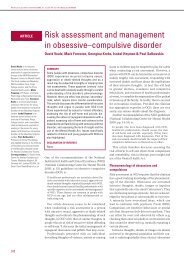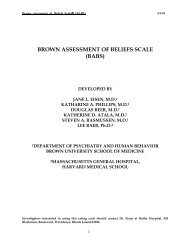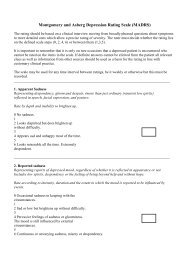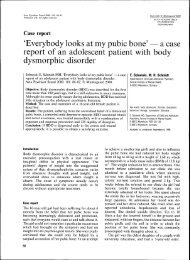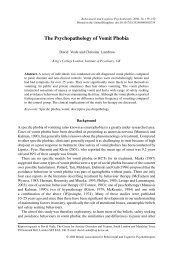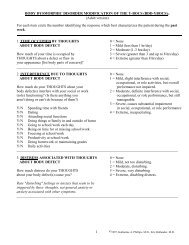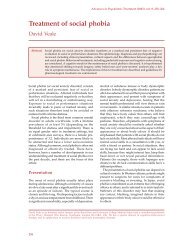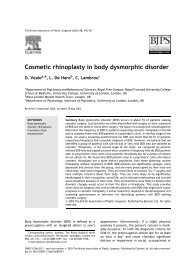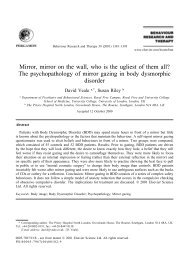Download - Dr David Veale
Download - Dr David Veale
Download - Dr David Veale
Create successful ePaper yourself
Turn your PDF publications into a flip-book with our unique Google optimized e-Paper software.
Advances in Psychiatric Treatment (2007), vol. 13, 438–446 doi: 10.1192/apt.bp.107.003699Cognitive–behavioural therapyfor obsessive–compulsive disorder<strong>David</strong> <strong>Veale</strong>AbstractIn the UK, the National Institute for Health and Clinical Excellence’s guidelines on obsessive–compulsivedisorder (OCD) recommend cognitive–behavioural therapy, including exposure and response prevention,as an effective treatment for the disorder. This article introduces a cognitive–behavioural model ofthe maintenance of symptoms in OCD. It discusses the process of engagement and how to develop aformulation to guide the strategies for overcoming the disorder.Delivering cognitive–behavioural therapy (CBT)for obsessive–compulsive disorder (OCD) requiresa detailed understanding of the phenomenologyand the mechanism by which specific cognitiveprocesses and behaviours maintain the symptomsof the disorder. A textbook definition of an obsessionis an unwanted intrusive thought, doubt, imageor urge that repeatedly enters a person’s mind.Obsessions are distressing and ego-dystonic butare acknowledged as originating in the person’smind and as being unreasonable or excessive. Aminority are regarded as overvalued ideas (<strong>Veale</strong>,2002) and, rarely, delusions. The most commonobsessions concern:• the prevention of harm to the self or othersresulting from contamination (e.g. dirt, germs,bodily fluids or faeces, dangerous chemicals)• the prevention of harm resulting from makinga mistake (e.g. a door not being locked)• intrusive religious or blasphemous thoughts• intrusive sexual thoughts (e.g. of being apaedophile)• intrusive thoughts of violence or aggression(e.g. of stabbing one’s baby)• the need for order or symmetry.A cognitive–behavioural model of OCD beginswith the observation that intrusive thoughts, doubtsor images are almost universal in the general populationand their content is indistinguishable from thatof clinical obsessions (Rachman & de Silva, 1978). Anexample is the urge to push someone onto a railwaytrack. The difference between a normal intrusivethought and an obsessional thought lies both in themeaning that individuals with OCD attach to theoccurrence or content of the intrusions and in theirresponse to the thought or image.Thought–action fusionAn important cognitive process in OCD is the waythoughts or images become fused with reality. Thisprocess is called ‘thought–action fusion’ or ‘magicalthinking’ (Rachman, 1993). Thus, if a person thinksof harming someone, they think that they will acton the thought or might have acted on it in the past.A related process is ‘moral thought–action fusion’,which is the belief that thinking about a bad actionis morally equivalent to doing it. Lastly, there is‘thought–object fusion’, which is a belief that objectscan become contaminated by ‘catching’ memories orother people’s experiences (Gwilliam et al, 2004).ResponsibilityOne of the core features of OCD is an overinflatedsense of responsibility for harm or its prevention.Responsibility is defined here as: ‘The belief that onehas power that is pivotal to bring about or preventsubjectively crucial negative outcomes. These outcomesmay be actual, that is having consequences inthe real world, and/or at a moral level’ (Salkovskis<strong>David</strong> <strong>Veale</strong> is an honorary senior lecturer at the Institute of Psychiatry, King’s College London and a consultant psychiatrist incognitive–behavioural therapy at the South London and Maudsley Trust (Centre for Anxiety Disorders and Trauma, The MaudsleyHospital, 99 Denmark Hill, London SE5 8AF. Email: <strong>David</strong>.<strong>Veale</strong>@iop.kcl.ac.uk; website: http://www.veale.co.uk) and the Priory HospitalNorth London. He is President of the British Association of Behavioural and Cognitive Psychotherapies, was a member of the NationalInstitute for Health and Clinical Excellence group that produced guidelines on treating obsessive–compulsive disorder (OCD) and bodydysmorphic disorder (BDD) and runs a national specialist unit at the Bethlem Royal Hospital for refractory OCD and BDD.438
Cognitive–behavioural therapy for OCDBox 1 Non-specific cognitive biasesOverestimation of the likelihood that harmwill occurBelief in being more vulnerable to dangerIntolerance of uncertainty, ambiguity andchangeThe need for controlExcessively narrow focusing of attention tomonitor for potential threatsExcessive attentional bias on monitoringintrusive thoughts, images or urgesReduced attention to real events•••••••in contact with a contaminant. Others feel ashamedand condemn themselves for having intrusivethoughts of, for example, a sexual or aggressivenature, that they believe they should not have.Occasionally, a person with OCD believes that theyare responsible for a bad event in the past; in suchcases, the main emotion is guilt. Many individualsare also depressed, with various secondary problemscaused by the handicap; comorbidity with a mooddisorder is relatively common. At times, anger,frustration and irritability are prominent. Because ofthe range of emotions, it is not surprising that somepatients find it difficult to articulate and untangletheir dominant emotion.et al, 1995). The difference in OCD is the individual’sappraisal of situations: the belief that harm mightoccur to the self, a loved one or another vulnerableperson through what the individual might do orfail to do. Harm is interpreted in the broadest senseand includes mental suffering; for example, somepeople with obsessive worries about contaminationfear they will go ‘crazy’ or that the anxiety will go onfor ever. Individuals with OCD believe they can andshould prevent harm from occurring, which leadsto compulsions and avoidance behaviours.Non-specific cognitive biasesPeople with OCD have a number of other cognitivebiases (Box 1) that are not necessarily specific tothe disorder but, in combination with cognitivefusion and an inflated sense of responsibility, lead toanxiety and compulsive symptoms. The excessivelynarrow focusing on monitoring for potential threats(e.g. fear of contamination from blood, resultingin constant checking for red marks), even whenno immediate threat is present, means that lessattention is focused on real events. This reduces theindividual’s confidence in their memory, which inturn leads to further checking behaviours. Intrusivethoughts, images or urges are often accompaniedby an excessive attentional bias on monitoringthem. This leads to a heightened cognitive selfconsciousnessand an increase in the detection ofunwanted intrusive thoughts and worries about notperforming a compulsion or safety behaviour.EmotionThe dominant emotion in an obsession may bedifficult for some patients to articulate but it iscommonly anxiety. Some also experience disgust,especially when they think that they could have beenCompulsions and safety-seekingbehavioursCompulsions are repetitive behaviours or mentalacts that a person feels driven to perform. Acompulsion can either be overt and observed byothers (e.g. checking that a door is locked) or a covertmental act that cannot be observed (e.g. mentallyrepeating a certain phrase). Covert compulsionsare generally more difficult to resist or monitor, asthey are ‘portable’ and easier to perform. The term‘rumination’ covers both the obsession and anyaccompanying mental compulsions and acts. Aswith obsessions, there are many types of compulsion(Box 2).Early experimental studies established thatcompulsions, especially cleaning, are reinforcingbecause they seem to reduce discomfort temporarily.Furthermore they strengthen the belief that, had thecompulsion not been carried out, discomfort wouldhave increased and harm may have occurred (ornot have been prevented). This increases the urgeto perform the compulsion again, and a viciouscircle is thus maintained. However, compulsionsdo not always work by reducing anxiety and areoften intermittently reinforcing. Compulsions mayfunction as a means of avoiding discomfort, as inexamples of obsessional slowness (<strong>Veale</strong>, 1993).Box 2 The most common compulsionsChecking (e.g. gas taps; reassuranceseeking)Cleaning/washingRepeating actionsMental compulsions (e.g. special words orprayers repeated in a set manner)Ordering, symmetry or exactnessHoarding••••••Advances in Psychiatric Treatment (2007), vol. 13. http://apt.rcpsych.org/ 439
<strong>Veale</strong>Compulsions are usually carried out in a relativelystereotyped way or according to idiosyncraticallydefined rules. The compulsion to hoard refers tothe acquisition of and failure to discard possessionsthat appear to be useless or of limited value, and tocluttering that prevents the appropriate use of livingspace (Frost & Hartl, 1996).The individual’s criteria for terminating compulsionsare an important factor in their maintenance.Someone without OCD finishes an action such ashand-washing when they can see that their hands areclean; someone with OCD and a fear of contaminationfinishes not only when they can see that their handsare clean but when they feel ‘comfortable’ or ‘justright’. Others may end a compulsion when theyhave a perfect memory of an event. These additionalcriteria for terminating compulsions may cause themto last even longer. Progress in overcoming OCDcan be made only when the criteria for terminatinga compulsion are restricted to objective criteria.A ‘safety-seeking behaviour’ is an action takenin a feared situation with the aim of preventingcatastrophe and reducing harm (Salkovskis, 1985);it therefore includes compulsions and neutralisingbehaviours. Neutralising is any voluntary or effortfulmental action carried out to prevent or minimiseharm and anxiety with the goal of either controlling athought or changing its meaning to prevent negativeconsequences from occurring (e.g. visualising thatthe doctor is telling me that I don’t have canceruntil I feel relief). Other safety-seeking behavioursinclude mental activities such as trying to be sureof the accuracy of one’s memory, trying to reassureoneself and trying to suppress or distract oneselffrom unacceptable thoughts. Such behavioursmay reduce anxiety in the short term but lead to aparadoxical enhancement of the frequency of thethought in a rebound manner.AvoidanceAlthough avoidance is not part of the definitionof OCD, it is an integral part of the disorder andis most commonly seen in fears of contamination.An example of avoidance is a woman with a fearof contamination who will not touch toilet seats,door handles or taps used by others. She will hoverover the toilet seat, use her elbow to open doorsand taps, use rubber gloves to put rubbish in thedustbin, avoid picking up items from the floor, avoidshaking hands with people or touching a substancethat looks dangerous to her. Avoidance can alsooccur mentally: trying not to think or feel somethingupsetting. Not all situations can be avoided andsafety-seeking behaviours are often used within afeared situation.Linking obsessions, compulsionsand avoidance behaviourThe content of obsessions, compulsions andavoidance behaviour in OCD are closely related.For example, when a patient has to touch somethingthat they normally avoid, the compulsive washingstarts. When avoidance is high, the frequencyof compulsions may be low, and vice versa. If awoman’s obsession is of stabbing her baby, shemight avoid being alone with him or put all knivesor sharp objects out of sight, ‘just in case’. If thisfails to reduce her obsession, she may ensure thatsomeone is with her all the time (a safety-seekingbehaviour) or try to neutralise the thought in herhead. These acts in turn increase her doubts andprevent her from disconfirming her fears, and thecycle continues.AssessmentClinical assessment of OCD is summarised in Box3. The assessment of avoidance requires a rating ofpredicted distress, so that a hierarchy of avoidedsituations without safety-seeking behavioursmay be identified for therapy, together with anunderstanding of how the avoidance interacts withthe obsessions and the distress experienced. Somepatients also try to avoid ideas, thoughts or imagesby distraction or attempts to suppress them.The patient’s problems, goals in therapy andvalued directions (e.g. to be a good parent andpartner) should be clearly defined. Progress shouldbe rated on standard outcome scales at regularintervals. The standard observer-rated tool is theYale–Brown Obsessive–Compulsive Scale (Goodmanet al, 1989). The Obsessive–Compulsive Inventory(Foa et al, 1998) is a standard subjectively rated scale.Patients are usually offered time-limited CBT forbetween 6 and 20 sessions, depending on the severityand chronicity of the problem. Patients with moresevere OCD may require a more intensive programmein a residential unit or in their home.Family involvementSome families accommodate an individual’s avoidanceand compulsions; some are overprotective,aggressive or sarcastic; they may minimise theproblem or avoid the individual as much as possible.Sometimes the behaviours associated with the OC<strong>Dr</strong>estrict the activities of family members (such asgaining access to the bathroom) or their freedom touse certain rooms in the home because of hoarding.People with OCD may react with aggression when440Advances in Psychiatric Treatment (2007), vol. 13. http://apt.rcpsych.org/
Cognitive–behavioural therapy for OCDBox 3 Areas to cover in clinical assessment• The context in which OCD has developed• The nature of the obsession(s): their content;the degree of insight; the frequencyof their occurrence; the triggers; the fearedconsequence (What is the worst thing thatcan happen?); the patient’s appraisal of theobsession (What did having the intrusivethought mean to you? What sense did youmake of it? Could harm occur as a result ofthis? What would happen if you could notget rid of the intrusions?)• The main emotion(s) linked with theobsession or intrusion• The compulsion(s) and neutralising: whatthe person does in response to the obsession;a rating of predicted distress if the compulsionis resisted; the feared consequences ofresisting it; their experience of trying to stop acompulsion; the criteria used for terminatingthe compulsion and the assumptions held ifthey stopped using a compulsion. Indirectassessment might include activities such asthe number of rolls of toilet paper or bars ofsoap used per week• The avoidance behaviour: all the situations,activities or thoughts avoided are listed andrated on a scale (e.g. 0–100 in standard unitsof distress), according to how much distressthe person anticipates if they experiencethe thought or situation without a safetyseekingbehaviour• The degree of family involvement• The degree of handicap in the person’soccupational, social and family life• Goals and valued directions in life• Readiness to change and expectations oftherapy, including previous experience ofCBT for the disordertheir compulsions are not adhered to by their family.Frequently, family members have different copingmechanisms, leading to further discord when theydisagree over the best way of dealing with thesituation. Assessment should focus on how differentmembers of the family cope and their attitudesto treatment. The goals of CBT include helpingfamily members to be consistent and emotionallysupportive, without accommodating the OCD. Theymay be encouraged to assist in exposure tasks andbehavioural experiments if these would facilitaterecovery from OCD.OCD in children and adolescentsChronic, severe OCD can be particularly disablingin young people, who often have little insight intotheir condition and are not ready to change. Usingthe Mental Health Act is usually unhelpful unlessfor a trial of medication, for reasons of physicalhealth or because there is a need to remove thepatient from their family and home environment.It is preferable to try to engage young patients inunderstanding the cognitive–behavioural model ofOCD and to help them follow their valued directionsin life despite the disorder. If the OCD is so severethat it prevents the individual from coping withoutsupervision, the parents may make their childhomeless and ask for the child to be rehoused, asthis may motivate the individual to change.Exposure and response preventionBehavioural therapy for OCD is based on learningtheory. This posits that obsessions have, throughconditioning, become associated with anxiety. Variousavoidance behaviours and compulsions prevent theextinction of this anxiety. This theory of the disorderhas led to ‘exposure and response prevention’, inwhich the person is exposed to stimuli that provoketheir obsession and then helped not to react withescape and compulsions; repetition of these stagesleads to extinction of the feared response. Exposureand response prevention remains a good evidencebasedtreatment for OCD (National CollaboratingCentre for Mental Health, 2005).The treatment methodFirst, a functional analysis is conducted and a hierarchyof the patient’s feared situations and thoughtsis generated. Graded exposure follows, beginningwith the stimuli that are the least anxiety-provoking.The rationale of habituation is explained to thepatient: repeated self-exposure to feared stimuliwill lead to extinction. Response prevention involvesinstructing the patient to resist the urge to carry outa particular compulsion and wait for the ensuinganxiety to subside. Patients are never forced to stopa compulsion, but the therapist may act as a modelfor exposure and response prevention and gentlyencourage the patient to follow. Compulsions maybe reduced gradually or patients instructed to delaytheir compulsive response for as long as possible. Apatient unable to resist a compulsion to wash theirhands would be asked to re-expose themselves tothe feared stimuli – for example recontaminatingthemselves by touching a toilet seat and thusnegating the effect of the compulsion.Advances in Psychiatric Treatment (2007), vol. 13. http://apt.rcpsych.org/ 441
<strong>Veale</strong>Therapist-supervised exposure is generally moreeffective than exposure and response preventionpractised alone by the patient as homework assignments.However, it is essential that the involvementof the therapist fades over time, with the patienttaking responsibility for their progress. Prolonged(90 minute) exposure sessions held several timesweekly with frequent homework will result in greatersymptom reduction. Combining actual and imaginedexposure is superior to actual exposure alone.Outcome with exposure and responsepreventionAbout 25% of patients refuse or drop out fromexposure and response prevention, and of thosethat adhere to the therapy about 75% improve(National Collaborating Centre for Mental Health,2005). Poor prognosis is associated with comorbidity(particularly depression or schizotypal personality);severe avoidance; overvalued ideation; expressedhostility from family members; and hoarding.Adding cognitive therapyAdding cognitive therapy to exposure and responseprevention includes many of the same procedures,but they are presented as behavioural experimentsto test out specific predictions. The emphasis isstill on behavioural change and following valueddirections in life. It attempts to improve engagementand provide a formulation that helps the patient toidentify a broader range of cognitive processes (e.g.inflated responsibility and thought–action fusion)that maintain symptoms of OCD. The approachis to question these processes and the patient’sappraisals of their intrusive thoughts and urges(not the content).Cognitive–behavioural therapy has now been foundto be superior to exposure and response prevention(P. M. Salkovskis, personal communication, 2007).Normalising intrusive thoughtsand urgesThe initial strategy in CBT is to normalise theoccurrence of intrusions and to emphasise that theyare irrelevant to further action. The patient mightbe presented with a long list of intrusive thoughtsand urges drawn from a community sample or examplesthat the therapist has personally experienced.Therapist and patient would then discuss thesimilarities of intrusive thoughts between peoplewith OCD and people without – that is, the content ofthe thoughts does not differ but the degree of distress,effort and duration does. Patients learn that intrusivethoughts and urges are part of the human conditionand are necessary for problem-solving and thinkingcreatively. Therapy therefore seeks to modify theway the individual interprets the occurrence and/or content of their intrusions, as part of a processof reaching an alternative, less threatening view ofintrusive thoughts. The conclusion to be drawn isthat the problem lies not with the intrusions but withthe meaning that the individual attaches to thosethoughts and the various strategies that they adoptto try to control or suppress them. Patients learn thattheir current strategies increase rather than controlthe frequency of intrusive thoughts, their levels ofdistress and the urge to neutralise their thoughts.Therapy in practiceThe formulationTake the example of Ella, a woman with OCDwho has intrusive thoughts of molesting a child.Her therapist would draw up a formulation of thefactors maintaining the symptoms and would shareit with her (Fig. 1). Engagement may be assisted bya Socratic dialogue and setting up two competingtheories to be tested out (Clark et al, 1998). Thetherapist’s side of such an interaction is outlined inBox 4. In this example, Ella was able to predict that ifBox 4 How does Ella prove to herself that herproblem is worrying that she is a paedophile?Therapist: ‘I want to see if we can build abetter understanding of what your problemis and therefore how to solve it. It seems tome there are two explanations to test out. Thefirst explanation, which I will call theory A,is the one you have been using for the pastfew years, that is, the problem is that you area paedophile. Theory B, which we would liketo test out in therapy, is that you are extremelyworried about being a paedophile and in yourvalues care very deeply about children.Have you noticed that treating it as theoryA makes the worry and distress about being apaedophile worse?Have you ever tried to deal with the problemas if was a worry problem?Would you be prepared to act as if it wastheory B for at least 3 months and then reviewyour progress? You can always go back totreating it as a paedophile problem if it’s notworking. This will mean gradually droppingall your safety and avoidance behaviours.’442Advances in Psychiatric Treatment (2007), vol. 13. http://apt.rcpsych.org/
Cognitive–behavioural therapy for OCDTrigger object, event or sensationBabysitting a nieceIntrusive thought, image or urgeI’m going to sexually molest herVAvoidance andsafety behavioursAvoid being alonewith niece andusual babysittingCVCompulsionsMentally checkwhetherI molested herCMeaning ofintrusive thought, imageor urgeThinking such thoughtsmeans I could be a paedophileand that I can’t have orlook after childrenAttentional biasMonitoring verycarefully levelof arousaland thoughtsVVCPhysicalfeelings andemotional reactionAnxiousAm I sexuallyaroused?CFig. 1 A formulation in obsessive–compulsive disorder.theory A were true and she really were a paedophile,then she would be feeling excited at the prospect ofbabysitting. If, however, theory B were true then shemight be feeling very worried and frightened aboutabusing her niece. The treatment strategy should beto reduce such worries (not to reduce the risk to achild), which were interfering with her ability to bea good aunt and wish to become a mother.Identifying cognitive processesThe therapist would discuss with Ella the processof cognitive fusion, her overinflated sense of responsibilityand other beliefs about her intrusive thoughtsor urges. She would be helped to differentiatebetween thoughts and actions with intention. Thismight involve behavioural experiments to test outtheory B and being alone with children. This isakin to traditional ‘exposure’, but because of thedetailed discussion and experiments on the nature ofintrusive thoughts, it may be more acceptable and lessdistressing than just ‘facing your fears’. The cognitive–behavioural model is presented in some detailand referred to throughout treatment – the aim forthe patient is not that she stops having intrusivethoughts but that she alters her relationship withher thoughts and develops an understanding of whysome strategies increase or decrease her symptoms.Further discussion would focus on the assumptionsinvolved in her appraisals of her thoughts (e.g. thetherapist might question the mechanism of howthinking can make an event happen and questionthe validity of an intrusive thought and how it canreflect an actual event). This may lead to a mentalexperiment of trying deliberately to induce badactions or events (e.g. having thoughts of causingthe therapist to have a serious accident before thenext appointment or having thoughts of harmingthe therapist while holding a knife against his orher neck).Safety behaviours and compulsionsThe therapist might conduct a functional analysis ofthe unintended consequences of Ella’s avoidance,safety behaviours and compulsions and how theyprevent disconfirmation of her worries. Patientstend to believe that their distress and worrywill continue unless they carry out their safetybehaviours or compulsions. This can be testedout in a behavioural experiment by asking thepatient deliberately to perform one of their lessdisturbing obsessions. For example Mark, a manwith OCD who fears being contaminated by HIV(see below), might be encouraged to perform hiscompulsion (e.g. checking and reassurance-seeking)on one day and on the next to resist the urge, oneach occasion monitoring the degree of his distressor worry and the effect on his confidence in hismemory. He would then be asked to compare thetwo experiences. Another experiment might involvethe paradoxical effect of thought suppression on thefrequency of the intrusive thoughts. This may leadto an experiment that involves asking the patient torecord the frequency of a neutral thought under twoconditions, with and without thought suppression.Advances in Psychiatric Treatment (2007), vol. 13. http://apt.rcpsych.org/ 443
<strong>Veale</strong>This may later be extended to their own intrusivethought. Behavioural experiments may appear tobe the same as exposure but with a rationale oftesting out certain beliefs about safety behavioursand making predictions about what would happenwere they not performed.DistancingAn important strategy is to help the patient distancethemselves from their thoughts or urges and tocease to engage in (‘buy into’) them. A metaphor forthoughts and urges are cars on a road. If one engageswith the cars (thoughts) then one might stand in theroad and try to divert them (and get run over) or tryto get into a car and park it. However, even whenone has managed to divert or to park one car thereare always more cars to be dealt with. The key is toacknowledge the thoughts (and thank one’s mindfor its contribution to one’s mental health), but notto attempt to stop them or to control them. The goalis to embrace intrusive thoughts and urges, to walkalong the side of the road, and to engage with life.This means always experiencing traffic noise in thebackground – intrusive thoughts never go away andreflect a person’s worries. If a patient struggles withdistancing themselves from their intrusive thoughts,this may be linked to beliefs about the consequencesof not responding to them (e.g. a person who fearsbeing contaminated may believe that they wouldlose control and go mad). In general, patients aretaught to notice and experience their thoughts andfeelings without trying to evaluate them or tryingto avoid or control them.Beliefs about contaminationThought–object fusion (described above) can be usedto enhance exposure to contamination. For example, aperson can put the tiniest drop of a contaminant (e.g.urine, saliva, semen) into a large volume of water, sothat the water has ‘thoughts’ of contamination. Thesolution can then be transferred to a hand-held spraywith which they can ‘contaminate’ themselves orpossessions for which they are responsible. This maylead them to question the process of thought–objectfusion, and the usefulness of excessive washing orcleaning and any specific predictions that they hadmade beforehand.Beliefs about intolerabilityof uncertaintyThe need for certainty is a common theme in OCD,especially for events in the distant future that areimpossible to disprove. For example Mark, the manwith OCD mentioned earlier, demands to knowfor certain whether he is HIV positive, despiterepeated reassurance from negative tests or positiveexplanations for his symptoms. Such patients alwayshave a nagging doubt – the blood sample couldhave been accidentally switched, there could be anew type of HIV which has not yet been discovered,the sero-conversion has not yet occurred and so on.Mark is demanding a 100% guarantee or absolutecertainty, which is of course impossible. However,while he continues to believe that he has to be100% certain, he will focus on the possible doubts.Obviously the feared situations are possible, butthey are highly improbable. It is important not toget involved in a detailed analysis of probabilitiesbut to help the patient to focus on the process andrecognise the link between the demand for certaintyand their distress and further doubt. This will helpthem to step back and focus on the much higherlikelihood of a poor quality of life if they continueto seek reassurance. Patients can be helped to tackletheir beliefs using humour: we can guarantee twothings in life – death and taxes! A third guaranteeis that while the patient continues to demand aguarantee that a feared consequence will not occurthey will continue to disturb themselves with theirsymptoms.Beliefs about terminatingcompulsive behavioursAs has already been noted, people with OCDtend to use problematic criteria such as being‘comfortable’, ‘just right’ or ‘totally sure’ to terminatea compulsion. Patients can be taught that they arediverting increasing amounts of attention andtrying too hard to determine the indeterminable(e.g. whether one can be totally sure everythinghas been done to make something clean). Patientswho check their memory have special difficulty.They are demanding to have a perfect or totallyclear picture of everything they have done, in theorder that it happened. Socratic questioning can beused to illustrate the impossibility of this demandand how each check creates further ambiguous dataand more scope for doubt. The criterion of ‘feelingcomfortable’ is particularly impossible to achievewhen confronting disturbing fears about the harmthat one may cause. In this case, patients shouldbe helped to focus their attention away from theirsubjective feelings and towards the external world(e.g. what they can see with their eyes or feel withtheir hands). Alternatively, patients may be shownthat demanding to feel comfortable or confidentbefore they can terminate a compulsion or confront444Advances in Psychiatric Treatment (2007), vol. 13. http://apt.rcpsych.org/
Cognitive–behavioural therapy for OCDa fear is akin to putting the cart before the horse.Patients usually need to do tasks uncomfortably andunconfidently before they can achieve comfort andconfidence in doing them.Hazards of cognitive therapyin OCDA hazard of cognitive therapy in inexperiencedhands is that the therapist becomes engaged insubtle requests for reassurance and arguments aboutminor probabilities. In such cases, it is especiallyimportant to use Socratic dialogue to help the patientgenerate the information needed by a behaviouralexperiment, or to ask the patient how a colleagueor relative would think or act. Most problems inCBT for OCD stem from two failures: challengingthe content of intrusive thoughts rather than thepatient’s appraisal of them or the cognitive process;and not spending enough time on exposure andbehavioural experiments. Always relate requestsfor reassurance or more information to the patient’sformulation and the cognitive–behavioural modelof OCD, with an emphasis on the effect of variouscognitive processes and behaviours.Key good practice points for using CBT aresummarised in Box 5 and further reading is suggestedin Box 6.Box 5 Good practice points in CBT for OCD• Patients should have clearly defined problemsand goals for therapy• There should be a shared formulation ofthe problem that provides a neutral explanationof the symptoms and of how tryingto avoid and control intrusive thoughts andurges maintains the patient’s distress anddisability• Do not become engaged in the content ofobsessions and requests for reassurance, anddo not argue about the likelihood of a badevent happening – help patients to use theirformulation and the cognitive–behaviouralmodel of OCD, and use a Socratic dialogueto focus on the process and consequencesof their actions• Do not give up using exposure and responseprevention: integrate it with the cognitiveapproach in the form of behavioural experimentsto make predictions• Ensure that patients do not incorporate newappraisals or self-reassurance as anothercompulsion or way of neutralisingBox 6 Further reading• Antony, M. M., Purdon, C. & Summerfeldt,L. J. (eds) (2007) Psychological Treatmentof Obsessive–Compulsive Disorder: Fundamentalsand Beyond. American PsychologicalAssociation.• Salkovskis, P. M. & Kirk, J. (2007) Obsessionaldisorders. In Cognitive Behaviour Therapy forPsychiatric Problems: A Practical Guide (edsK. Hawton, P. M. Salkovskis, J. Kirk, et al),pp. 129–168. Oxford University Press.• <strong>Veale</strong>, D. & Willson, R. (2005) OvercomingObsessive Compulsive Disorder: A Self-HelpGuide Using Cognitive Behavioral Techniques.Constable & Robinson.• Wells, A. (2000) Emotional Disorders andMetacognition, pp. 179–199. John Wiley &Sons.Declaration of interestNone.ReferencesClark, D. M., Salkovskis, P. M., Hackmann, A., et al (1998)Two psychological treatments for hypochondriasis. A randomisedcontrolled trial. British Journal of Psychiatry, 173,218–225.Foa, E. B., Kozak, M. J., Salkovskis, P. M., et al (1998) Thevalidation of a new obsessive-compulsive disorder scale: theObsessive–Compulsive Inventory. Psychological Assessment,10, 206–214.Frost, R. O, & Hartl, T. L. (1996) A cognitive–behavioural modelof compulsive hoarding. Behaviour Research and Therapy, 34,341–50.Goodman, W. K., Price, L. H., Rasmussen, S. A., et al (1989) TheYale-Brown Obsessive Compulsive Scale. I: development, useand reliability. Archives of General Psychiatry, 46, 1006–1011.Gwilliam, P., Wells, A. & Cartwright-Hatton, S. (2004) Doesmeta-cognition or responsibility predict obsessive–compulsivesymptoms: a test of the metacognitive model. Clinical Psychologyand Psychotherapy, 11, 137–144.National Collaborating Centre for Mental Health (2005) Obsessive–Compulsive Disorder: Core Interventions in the Treatment ofObsessive–Compulsive Disorder and Body Dysmorphic Disorder(Clinical guideline CG31). British Psychological Society &Royal College of Psychiatrists. http://www.nice.org.uk/CG031Rachman, S. J. (1993) Obsessions, responsibility and guilt.Behaviour Research and Therapy, 31, 149–154.Rachman, S. J. & de Silva, P. (1978) Abnormal and normalobsessions. Behaviour Research and Therapy, 16, 233–248.Salkovskis, P. M. (1985) Obsessive–compulsive problems: acognitive–behavioural analysis. Behaviour Research and Therapy,23, 571–583.Salkovskis, P. M., Richards, C. H. & Forrester, E. (1995) The relationshipbetween obsessional problems and intrusive thoughts.Behavioural and Cognitive Psychotherapy, 23, 281–299.Advances in Psychiatric Treatment (2007), vol. 13. http://apt.rcpsych.org/ 445
<strong>Veale</strong><strong>Veale</strong>, D. (1993) Classification and treatment of obsessionalslowness. British Journal of Psychiatry, 162, 198–203.<strong>Veale</strong>, D. (2002) Over-valued ideas: a conceptual analysis.Behaviour Research and Therapy, 40, 383–400.MCQs1 Neutralising an intrusive thought or image:a leads to an immediate increase in anxietyb is an involuntary strategy adopted by the patientc aims to create more harmd prevents disconfirmation of the intrusive thoughte is identical to a compulsion.2 Cognitive processes in OCD include:a thought–action dissociationb tolerance of uncertaintyc overinflated sense of responsibility for harmd finishing washing ritual when seeing that one’s handsare cleane underestimation of the likelihood of harm.3 Compulsions in OCD:a can lead to psychosis if resistedb may initially function as a means of avoidinganxietyc can be resisted by focusing attention inwards onsubjective feelings and not by external informationd are entirely voluntarye cannot be mental acts.4 Unwanted intrusive thoughts and images:a are indistinguishable in content between people withOCD and the ‘normal’ populationb can be suppressed in the long termc do not differ in the meaning that people with OCDattach to their occurrence and/or content comparedwith the ‘normal’ populationdeare unnecessary for thinking creatively and problemsolvingare rare in the general population.5 Assessment for cognitive–behavioural therapy inOCD:a does not require knowledge of the degree of familyinvolvementb does not require knowledge of the patient’s degree ofinsight or overvalued ideationc requires forensic assessment of intrusive thoughts andurgesd requires assessment of the patient’s readiness tochangee requires analysis of countertransference.MCQ answers1 2 3 4 5a F a F a F a T a Fb F b F b T b F b Fc F c T c F c F c Fd T d F d F d F d Te F e F e F e F e F446Advances in Psychiatric Treatment (2007), vol. 13. http://apt.rcpsych.org/



